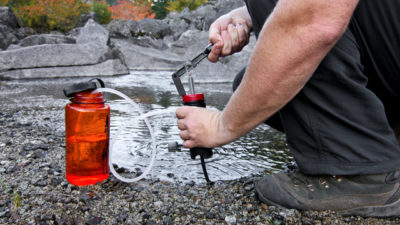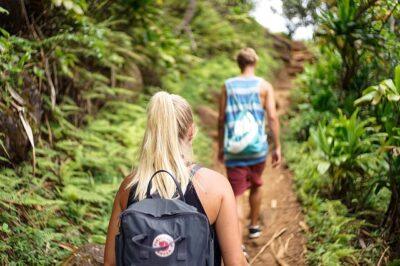There are quite a few stark differences between gear that you might find on a soldier, hunter or hiker — and those that you might find on a survivalist or bushcrafter. One of the biggest aspects in this difference comes down to how they contain and carry their vital water resources.
For outdoorsmen and military personnel, you’ll often see them carrying their water in a Camelbak, Nalgene or a simple plastic bottle. And there is a good reason for this, especially since these options are lightweight, somewhat durable, and easy to use (honestly, it doesn’t get much easier than sucking H2O from the nozzle on your shoulder, that’s for sure).
However, this is the point at which a survivalist ends up at a disadvantage in using these gear options. When lost in the wilderness, there is no basecamp, lodge or command post to return to for resupply.
Solutions? Ah, but of course. There are always solutions.
What To Carry
This is why I prefer using a stainless steel water bottle system for this particular application. A set of a few 27- or 40-ounce Klean Kanteen bottles can provide a survivalist with a variety of some very convincing gear advantages. For instance …
- As opposed to Nalgene or Camelbak system, stainless steel water bottles will not shatter or puncture. A Klean Kanteen bottle may dent or crack (but a crack can be solved with duct tape, like most things in this world).
- For uncolored stainless steel water bottles, a little polishing will reveal a semi-reflective surface — at least, good enough to twinkle in the eye of search and rescue teams.
- MOST importantly, this is where we get into the water sanitation aspect: These bottles will not melt (just make sure you remove the cap before placing it in or around a campfire).
Why should we be concerned about our stainless steel water bottle’s ability to handle immersion in a campfire? Simple: Because that’s exactly what we’re going to do.
‘Pocket Water Filter’ Removes 100 Percent Of Water-Borne Bacteria!
True, there are survival straws but, quite frankly, I wouldn’t want to be tethered to the 50-gallon maximum filtering limit on a survival straw, because I don’t know when, where, or for how long I will be stuck out there. For a much better option, try a paratrooper filter, which filters more than 500 gallons and can fit in your pocket. (You could pack several of them.)
 Boiling water also is an option. A highly informative article by Ben Crowell discusses the bacterial particulars, saying that boiling ensures that all bio-nasties have been effectively nuked at boiling point:
Boiling water also is an option. A highly informative article by Ben Crowell discusses the bacterial particulars, saying that boiling ensures that all bio-nasties have been effectively nuked at boiling point:
“If you’re boiling water for use in cooking, then the water is already pasteurized before it reaches the boiling point. It is not necessary to use filtering or chemical treatment, and iodine treatment may even cause foods like instant mashed potatoes to turn a funny color. It is not necessary to boil for a certain amount of time in order to kill microorganisms. Protozoa cysts are killed rapidly at about 55 C (131 F).”
This Crazy New Device Can Start A Fire Even In The Worst Conditions
Keep in mind that boiling water will not have any effect against hard metals and other toxic chemicals in the water, but the most dangerous bits, and most difficult to filter out, have been neutralized.
How Much Water Should I Carry?
In a post from SectionHiker.com the author tells of the olden days when he would carry four liters (about one gallon) of water on him, even during experimentation with lightweight thru-hiking systems. In most cases today, hikers will usually carry around two liters (about half a gallon). But what if water resources run dry? In our case, I would still advise that survivalists opt for a gallon-carrying capacity for a few reasons.
Since you won’t be covering lots of distance, like a day or thru-hiker, then water should be one resource that’s worth the extra weight to carry.
Also, because it takes a great deal more time and effort to start a fire and bring four liters of water to boil (in comparison to a filtration system), then it’s best to process your entire water supply all at once.
Packing a set of stainless steel bottles offers a combo/compromise between a featherweight option and a highly functional system. Obviously, stainless steel is certainly going to be much heavier than its plastic alternatives. However, stainless steel also provides a multi-purpose piece of gear, for the reasons I mentioned above. It’s your sanitation system and can signal … and can even produce usable char cloth for fire-making in a pinch.
What do you think? How much water should a person carry, and what is the best way to filter water? Share your thoughts in the section below:
Stranded And Lost? Learn How To ‘Live Off The Land’ With Your Gun. Read More Here.
 Off The Grid News Better Ideas For Off The Grid Living
Off The Grid News Better Ideas For Off The Grid Living




